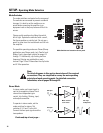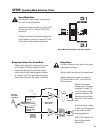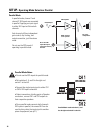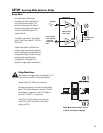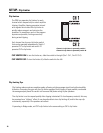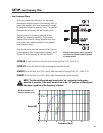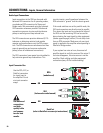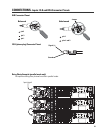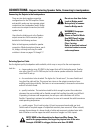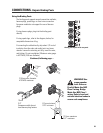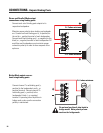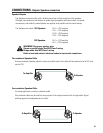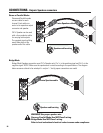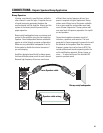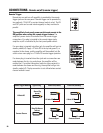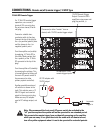
22
Connecting the Outputs to the Loudspeakers
There are two basic speaker connection
configurations for the SRA amplifier. Stereo
and parallel modes use two separate output
connections (two loudspeaker loads). Bridge
mode uses one output connection (one loud-
speaker load).
Use either the binding post or the Speakon
output connectors. Each connector type is
detailed in the following sections.
Refer to the diagrams provided for speaker
connection. Mode descriptions (stereo, paral-
lel, bridge, or biamp) and using the mode
switches is shown on pages 14 through 17.
CONNECTIONS- Outputs: Selecting Speaker Cable, Connecting to Loudspeakers
Selecting Speaker Cable
Use the highest quality loudspeaker cable available, which may or may not be the most expensive.
Look for...
NOTE! AWG is the abbreviation for American Wire Gauge. The
smaller the gauge number, the larger the physical size of the wire.
Example: #10 AWG is a bigger, thicker wire than #16 AWG.
• ...large conductor size: #10 AWG is the largest that will fit the binding posts. Smaller
wire sizes, like #12 or #14 AWG may be fine for shorter speaker cable use. Avoid small
sizes like #16 and up.
• ...the conductors to be stranded. The higher the “strand count”, the more flexible and
long-lived the cable will be. This means less stress on the output connectors of your
amplifier and higher reliability. Solid wire is not recommended; it stresses the connectors
and will fail when flexed.
• ...quality insulation. The insulation should be thick enough to protect the conductors
wherever they are installed and be flexible enough that handling the cable is not difficult.
If operating in extreme cold temperatures, be sure your cable insulation will still be
flexible. If operating in extreme hot conditions, be sure not to exceed the cable’s maximum
rated operating temperature.
• ....quality copper. This is hard to judge; it’s best to use name brand cable you trust.
Cables made of recycled copper of unspecified resistivity have some risk. When in doubt,
measure the resistance of a known length of cable and compare to standard wire table
data. Whether or not the copper has small amounts of oxygen is of little impact.
Do not use less than 4-ohm
loads in Bridge mode!
Note polarity of connec-
tions for Bridge mode.
WARNING! Use proper
speaker wire.
Stereo or Parallel Mode:
Use NEC Class 2 wiring.
Bridge Mode: Use NEC
Class 1 wiring.
Refer to local and national
electrical codes to assure
code compliance.



